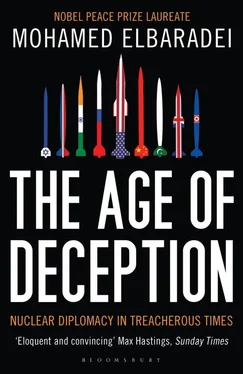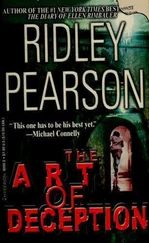On August 3, 2005, Ahmadinejad assumed the Iranian presidency and began working on cabinet appointments. Two days later, Rowhani and his team were replaced; Ali Larijani was announced as the new secretary of Iran’s Supreme National Security Council. The Iranians quickly began feeding uranium oxide into an unsealed portion of the conversion facility in Isfahan. On August 10, after formally receiving the European offer, Iran removed the IAEA seals from the rest of the facility.
The IAEA Board met in special session and issued a resolution urging Iran to reestablish its suspension. On September 24, at its next meeting, the Board went further, for the first time characterizing Iran’s history of concealment and reporting failures as constituting “noncompliance.” The term made eventual referral to the UN Security Council a certainty.
A new phase of the Iranian nuclear crisis had begun.
The standard NPT safeguards agreement makes it discretionary for the IAEA Board to refer “noncompliance” to the UN Security Council. In the case of Iran, I had long been careful to avoid using the word noncompliance , opting instead for synonyms such as breach or violation , so as not to prejudice the Board. The Board had in the past declined to refer Iran to the council, retaining the possibility as a bargaining chip in negotiations. The Americans had wanted to report Iran to the council from day one and specifically criticized the Agency for not using the term noncompliance .
What made Iran’s eventual referral a cause for cynicism was that there was nothing new in its “noncompliance,” which had essentially been known for two years. Recent developments had been positive: the Agency had made substantial progress in verifying Iran’s nuclear program. The eventual referral, when it came, was primarily an attempt to induce the Security Council to stop Iran’s enrichment program, using Chapter VII of the UN Charter to characterize Iran’s enrichment—legal under the NPT—as “a threat to international peace and security.”
I have frequently been asked whether I thought the international community missed an opportunity at this point for a peaceful resolution of the Iranian nuclear question. If the Europeans had been more resourceful, or if the Americans had not blocked the export of French technology and understood the value of incentives for Iran, would the crisis have been over by now?
We cannot know what might have happened had this or that variable been different. The situation was extraordinarily complex for each of the players involved—and even more so in combination. The layers of intention on the part of the relevant governments—of Iran, the United States, the EU-3, and others—were nearly impossible to read with certainty.
What is clear, though, is that Iran believed that cooperation with the Agency would prevent its referral to the Security Council and that negotiations with the Europeans were seen as an intermediate step on the path to a grand bargain with the United States. These were their essential policy objectives. When these results did not materialize—a reality that became painfully transparent with the August 2005 offer and the subsequent referral for noncompliance—Iran immediately diminished its cooperation with the Agency, possibly hoping to force a concession from the West.
It also became clear, in the months and years that followed, that the West’s insistence on taking a hard line—refusing Iran’s request to retain some small element of their nuclear program—achieved nothing. The most amorphous of principles trumped pragmatism. Had the EU-3 offered Iran a reasonable package, with concrete benefits, the Iranians, I believe, would have been willing to suspend their enrichment program, or at least to limit it to a small R&D operation while negotiations toward a grand bargain continued. Iran’s requirement was access to Western technology—both nuclear power technology and other technology they had been denied under U.S. sanctions. Because of U.S. opposition, such an offer did not materialize. The result—inevitable and easily foreseen—was a raising of the stakes: Iran resumed uranium conversion operations and, later, enrichment. The more time that passed, the higher Iran’s “price” became.
The international community did not immediately give up on finding a negotiation pathway. In November 2005 a new proposal was made to allow Iran to convert uranium at Isfahan and ship the resultant UF 6to Russia for eventual enrichment for Iran’s reactor fuel. But the forces against it were too strong.
6
LIBYA
Discovery and Dismantlement
The first hint of something askew in Libya’s nuclear ambitions came to me in a meeting at the British embassy in Vienna. It was May 2003. The principal skeleton being dragged from the closet was Iran, but almost as an afterthought, a senior member of MI6, the British secret intelligence service, mentioned that there might also be some concerns related to Libya. He referred to a research reactor in Tajura, a small city east of Tripoli, without saying why. When I pressed for more details, he promised to invite me to London for an in-depth briefing.
When certain Americans in the State Department got wind that MI6 planned to meet with me, they intervened, urging the United Kingdom not to pass their information to the IAEA. This was characteristic: the United States tended to be reluctant about sharing intelligence, even with the head of the UN organization charged with preventing the spread of nuclear weapons. The British were more relaxed on this front. [1] This was not the only difference. The Americans usually had definite views about how to interpret their raw information, whereas the British came across as less opinionated, letting the facts speak for themselves. Interestingly, my contacts at MI6 told me that, although the CIA director briefed the U.S. president each morning, the CIA, unlike MI6, was rarely involved during the actual decision-making process.
In any case, eight months later I still had not received the promised briefing.
On December 18, 2003, Graham Andrew, my British assistant and confidant, stopped by my office. Based on a message he had received from British intelligence, a major announcement about Libya was imminent. It was coming jointly from President Bush and Prime Minister Blair. Graham hinted that it might be prudent for me to postpone my long-planned trip to India the next morning. That night I received a call from Matouq Mohammed Matouq, the Libyan deputy prime minister of science and technology. The foreign minister, he said, was about to go public with a Libyan decision to dismantle its WMD programs. The very existence of Libyan WMD development was news to me. Matouq asked if he could come and brief me in Vienna. My India trip would have to wait.
Matouq showed up the next day with a small Libyan army of nineteen or twenty diplomats, scientists, and other officials. A short man with piercing eyes and hair dyed jet black, Matouq had been part of the senior echelon in Libya for many years. He was respectful and professional, but not in the least apologetic. Following the introductions, we had a one-on-one meeting and got down to business.
The gist of the story was that Libya had been working for years on a uranium enrichment program. [2] I was told that the genesis of the Libyan nuclear weapon program—and Gaddafi’s other WMD programs—was in retaliation for the April 1986 U.S. bombing raids during which Gaddafi’s adopted daughter, Hannah, was killed.
They had received equipment, knowhow, and design support through the Pakistani nuclear scientist and businessman A. Q. Khan and from a network of companies and individuals. As Matouq spoke, I became aware that I was in effect receiving my first briefing on the extent and complexity of the nuclear black market. Matouq talked about assistance Libya had received from contacts in South Africa. He related an incident that even in the telling had a multinational flavor: a U.S. and U.K. intelligence tip-off had led to an Italian raid off the coast of Taranto on a German freighter, the BBC China , caught in the act of bringing nuclear equipment to Libya that had been manufactured by a company in Malaysia.
Читать дальше












